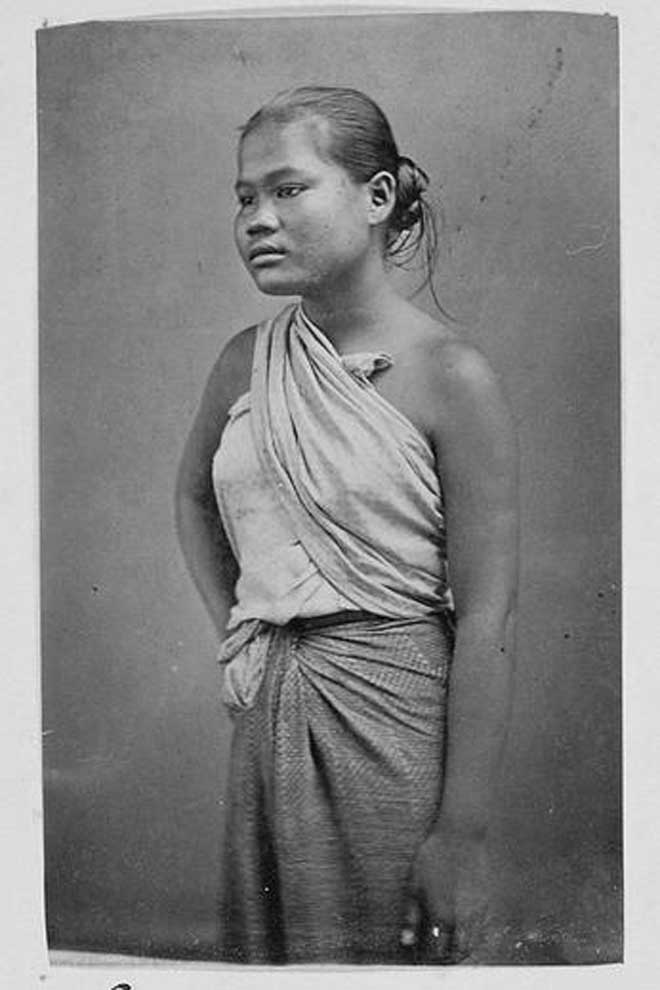
Gsell posed his subjects outdoors in front of a fabric backdrop. Photo supplied
French linguist and archaeologist Etienne Aymonier is best known for his systematic surveys of the ruins of the Khmer Empire. But his Notice sur le Cambodge (Notes on Cambodia) has been translated into English for the first time and released alongside some of the earliest photographs of Cambodia.
Aymonier advanced steadily in the administrative government in Vietnam but became increasingly involved in the affairs of Cambodia, where he assisted the explorer Louis Delaporte with an 1873 archaeological expedition and was later assigned the task of delineating the Kingdom’s Vietnamese border.
Notes sur le Cambodge was likely published during a trip back to France in 1875. The original volume comes from the bookshelf of an American collector, Joel Montague, who has written a book on 19th-century photographer John Thomson. For the new volume, which they retitled Cambodia Past: Explaining the Present, Montague enlisted the assistance of his co-author on the Thomson project, Phnom Penh-based photographer Jim Mizerski.
Mizerski says the new book addresses a relatively small audience: “people who have been in Cambodia for a little while, and want to get a little idea of what it used to be like”. And those readers will quickly notice similarities between the past and present, as the title suggests. Much of Aymonier’s careful chronicling of customs is focused specifically on the traditional seats of power and a feudal system of rents and titles.
The Cambodia the Frenchman describes is an absolute monarchy, but one with familiar names – samdech, oknha – as well as systemic exploitation. The king is the ultimate arbiter of justice, with the rights and debts of many dished out to few for profit.

Emile Gsell was one of the first to document Cambodians. Photo supplied
“What was accepted then is considered corruption today,” Mizerski says. “In the 1860s, the king owned everything.” Also memorable is Aymonier’s cultural commentary. For every offhanded Orientalising remark – “ . . . according to the most competent Cambodians, if there are any”, he writes – there is a host of detailed descriptions of unique groups and practices, including a particularly rich passage on a traditional Khmer wedding.
The small volume is illustrated with photographs dating to the 1860s. (A larger collection of these photographs – some of the earliest taken in the Kingdom – is included in a book published by Mizerski earlier this year, Cambodia Captured.) Nearly all of them were taken by Emile Gsell, a French photographer based in Saigon, who travelled with Admiral Doudart de Lagree up the Mekong River.
Though Gsell made only a few trips to Cambodia in his lifetime, he was the first to capture many aspects of its culture – young monks, musicians, racing boats used for the annual Water Festival in Phnom Penh.
The relatively short text, paired with Gsell’s rich photographs, make Cambodia Past a nice selection for anyone looking for a quick read on an era not so far from our own.
Cambodia Past: Explaining the Present (DatAsia Press, 112pp) is available at Monument Books for $12 (paperback). A second edition of Mizerski’s Cambodia Captured is also now on sale.
Contact PhnomPenh Post for full article
SR Digital Media Co., Ltd.'#41, Street 228, Sangkat Boeung Raing, Khan Daun Penh, Phnom Penh, Cambodia
Tel: +855 92 555 741
Email: [email protected]
Copyright © All rights reserved, The Phnom Penh Post



